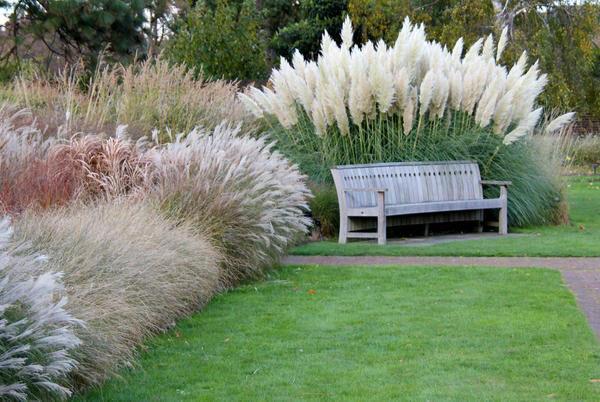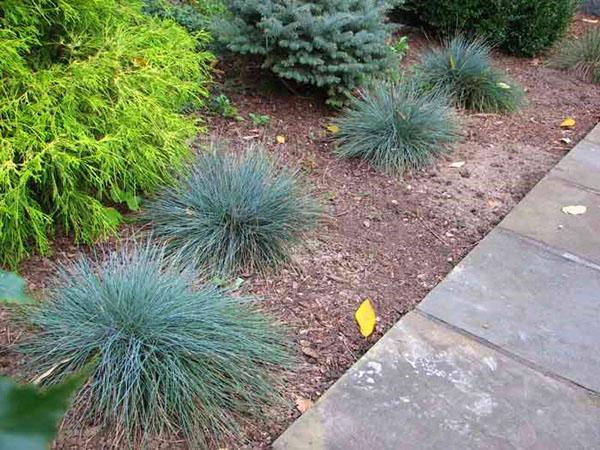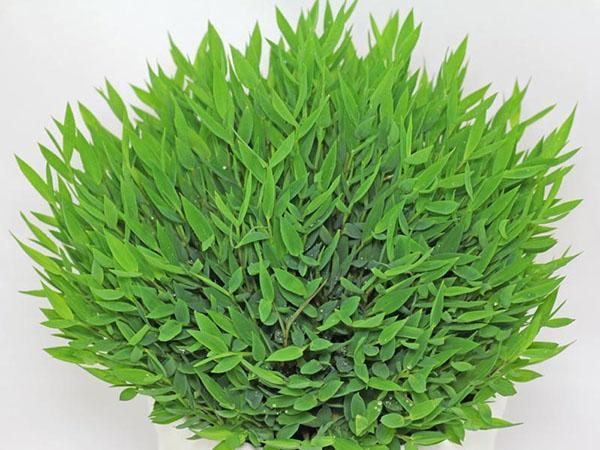Types of decorative cereals and their use in landscape design
 Ornamental cereals are an excellent solution for decorating a summer cottage, park or recreation area. They can be low or reach large sizes, forming brushes of different shapes and colors. These plants are unpretentious to keeping conditions, therefore they are actively used to create landscape compositions of varying complexity.
Ornamental cereals are an excellent solution for decorating a summer cottage, park or recreation area. They can be low or reach large sizes, forming brushes of different shapes and colors. These plants are unpretentious to keeping conditions, therefore they are actively used to create landscape compositions of varying complexity.
Plant varieties
Cereal plants differ from each other, but they can be easily combined. The main condition for choosing neighbors is that they should feel good on the same type of soil with identical moisture content. An overview of the most popular ornamental cereals with names and photos will help to determine the specific type of plant.
Blue fescue

Fescue is considered a heat-loving plant, therefore, it is started to be planted in the ground in June, when the soil is completely warmed up. There are a few more rules that should be followed so that the bushes grow bright and neat:
- the soil must be well drained, moisture stagnation is not allowed (soil with a high sand content is best suited);
- every 4 years, the bushes must be divided;
- it is recommended to replant the plant every 2 years, otherwise the leaves may become pale.
Fescue is one of the lawn plants. It is grown to decorate flower beds, paths, arbors. It is especially useful in areas with insufficient fertile soil, which is not suitable for other varieties of plants.
Pogonaterum millet
 Among all the ornamental grasses and grasses in landscape design, the millet pogonaterum is the most unusual. Its second name is indoor bamboo, since the two plants are related. The stems of an adult plant resemble real bamboo thickets in miniature. The leaves are bright, can have different shades of green.
Among all the ornamental grasses and grasses in landscape design, the millet pogonaterum is the most unusual. Its second name is indoor bamboo, since the two plants are related. The stems of an adult plant resemble real bamboo thickets in miniature. The leaves are bright, can have different shades of green.
Pogonaterum is a perennial cereal plant, but it is recommended to grow it at home in a warm place. The air temperature for this variety of cereals should not fall below 18 degrees. Frost will lead to his death, but in the summer the pot with the plant can be taken outside.
Indoor bamboo is not a very easy plant to care for, the owner will have to fulfill several basic requirements:
- the site should be well lit, the pogonaterum is not afraid even of direct sunlight;
- watering is done regularly even in winter, the upper part of the soil should not dry out;
- it is also recommended to spray green mass from a spray bottle.
Unlike many other ornamental grasses and garden grasses, indoor bamboo requires constant feeding. It may be normal mineral fertilizer for indoor plants, which is added twice a month to water for irrigation. The soil for growing the pogonaterum will also be different. Since the plant does not tolerate drying out, the soil must contain a large percentage of clay. It is recommended to add peat, humus or other mineral fertilizers to the seedling mixture.
Maned barley
 Maned barley is another cereal plant that is often used in landscape design. Outwardly, it resembles ordinary barley and retains all the positive characteristics of this variety. The plant tolerates frost well, so it can be safely planted in flower beds where thermophilic varieties have not taken root.
Maned barley is another cereal plant that is often used in landscape design. Outwardly, it resembles ordinary barley and retains all the positive characteristics of this variety. The plant tolerates frost well, so it can be safely planted in flower beds where thermophilic varieties have not taken root.
Barley is one of those varieties that grow rapidly and capture new areas. Periodically, the bushes need to be thinned out so that the flowerbed looks neat. In temperate climates, the plant can remain outside for the winter, but if frosts occur, it is better to dig it up and move it to a house or greenhouse.
Routine thinning of bushes or limiting growth space is not enough. Barley reproduces well as seeds, so they must be cut before they are fully ripe.
Cortaderia
 Cortaderia is a perennial cereal plant that can grow up to 3 m in height. It should not be combined with other, less vigorous, varieties, as it forms a strong root system and uses all the nutrients from the soil. In addition, it is worthwhile to think in advance how the cortaderia will fit into the overall composition - if it is planted once, it will not be easy to get rid of it.
Cortaderia is a perennial cereal plant that can grow up to 3 m in height. It should not be combined with other, less vigorous, varieties, as it forms a strong root system and uses all the nutrients from the soil. In addition, it is worthwhile to think in advance how the cortaderia will fit into the overall composition - if it is planted once, it will not be easy to get rid of it.
The leaves of this plant are strong and flexible. In late summer and early autumn, panicles up to 50 cm long are formed on them. Individual inflorescences have smooth long villi, painted in cream, white or beige. The panicles are above human height and resemble clouds.
Cortaderia is a cereal plant that does not dictate any conditions for care. It grows well in abandoned areas, capturing new territories every year. It is also protected from pests, direct sunlight, drought and flooding. At home, it can be watered every 2 weeks, and adult plants need this procedure even less often.
How to choose and care for cereals?
To make decorative cereals look neat and well-groomed, there are several rules for planting them. The peculiarity of these plants is that they grow rapidly and can hinder the development of neighbors. If you do not restrain their growth, neat flower bed will look as if it has not been treated for weeds for a long time.
 When planting ornamental cereals, you can use one of the tips:
When planting ornamental cereals, you can use one of the tips:
- use infertile soils with a high sand content (plants will develop in these conditions);
- limit the growth of bushes with decorative stones, pebbles or sand mounds;
- the most aggressive varieties are recommended to be placed in separate pots and then lowered into the ground.
Unlike many other plants, cereals do not need feeding. On the contrary, fertilizers can provoke too intensive growth, due to which the bushes can lose their shape.
Ornamental cereals are propagated by seedlings or seeds, it depends on the specific variety. Cereal seeds will germinate at a comfortable temperature, but in some varieties it is better to germinate them separately. If they are immediately placed in the main place, growth may be inhibited by larger flowers or bushes. It is not necessary to grow seedlings in pots at home - you can simply form a separate bed for them, and transplant immediately, as a small bush is formed.
Cereals in landscape design are a fashionable trend that is increasingly being used not only to decorate flower beds and hedges, but also to create a special atmosphere in parks or recreation areas. Depending on the type of plant, it will either complement the composition of other bushes and flowers, or act as the main decoration. They look great without adding other varieties in the composition hedges and around artificial reservoirs.